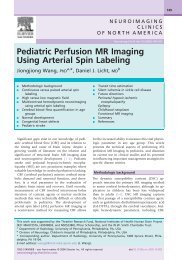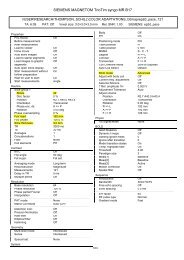Arterial Spin Labeling Perfusion MRI Signal Processing Toolbox ...
Arterial Spin Labeling Perfusion MRI Signal Processing Toolbox ...
Arterial Spin Labeling Perfusion MRI Signal Processing Toolbox ...
You also want an ePaper? Increase the reach of your titles
YUMPU automatically turns print PDFs into web optimized ePapers that Google loves.
1. Introduction<br />
This is a brief tutorial 1 to the <strong>Arterial</strong> <strong>Spin</strong> Labeled <strong>Perfusion</strong> <strong>MRI</strong> data processing toolbox (ASLtbx), a<br />
MATLAB (Mathworks Inc.) and SPM (Wellcome Department, UCL) -based toolkit for processing ASL<br />
data acquired with either the pulsed ASL (PASL) or continuous ASL (CASL) or the pseudo-CASL<br />
technique 2 . The toolbox is free for academic users, and can be obtained from<br />
http://cfn.upenn.edu/~zewang/ under the GPL license. The original GPL license and the file header<br />
should be included in any modified versions. Example datasets for resting ASL and functional ASL with<br />
customized settings are also available through the website. Both the toolbox and the sample data are<br />
not allowed for any commercial use without formal permission from the University of Pennsylvania. We<br />
are not and will not be responsible for any use which is made of this package. By providing exemplar<br />
data, no references or gold standards for the images, blood measures, and any kind of resultant<br />
outcomes are implied. We further disclaim any liability and accuracy of the outcomes arising from using<br />
this package. We are not responsible for any data interpretations. All the code and the data are provided<br />
as they were.<br />
Some basic concepts about f<strong>MRI</strong> and ASL <strong>MRI</strong> are assumed from ASLtbx users before running it. Basic<br />
Matlab script programming skills will be required too. Please cite the toolbox and the related papers if<br />
you are using it or modifying the code. We are happy to help and happy to collaborate.<br />
For the users who are only interested in cerebral blood flow (CBF) quantification, section 3 and 4 can be<br />
skipped.<br />
1.1 Theory and background<br />
ASLtbx is a collection of processing steps for ASL data. The premier version of the pipeline and the<br />
toolkit were first described in the following paper:<br />
1) Ze Wang, Geoffrey Aguirre, Hengyi Rao, JiongJiong Wang, Anna R. Childress, John A. Detre,<br />
Empirical ASL data analysis using an ASL data processing toolbox: ASLtbx, Magnetic<br />
Resonance Imaging, 2008, 26(2):261-9.<br />
and further enhanced in:<br />
2) William T. Hu*, Ze Wang*, Virginia M.-Y. Lee, John Q. Trojanowski, John Detre, Murray<br />
Grossman, Distinct Cerebral <strong>Perfusion</strong> Patterns in FTLD and AD, Neurology, 2010 Sep<br />
7;75(10):881-8. (contributed equally).<br />
1<br />
This manual was first drafted by Zhengjun Li on 2009.<br />
2<br />
All references can be easily found in pubmed and in the code, though a list will be provided in later version.<br />
4






